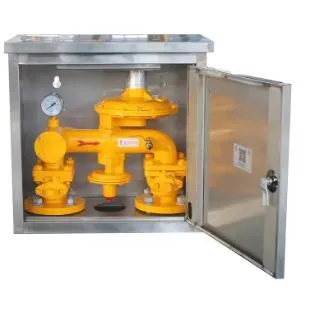
May . 16, 2025 14:19
Back to list
How Do Filter Separators and Pressure Control Devices Enhance Natural Gas Systems?
In industrial and energy - related applications, maintaining the efficiency and safety of gas systems relies on specialized components. Among these, filter separators, natural gas filters, gas pressure reducing valves, gas pressure reducers, and regulating valves play pivotal roles in ensuring optimal performance. These devices are designed to address specific challenges in natural gas processing, distribution, and usage, from removing contaminants to controlling pressure fluctuations.

What Is the Role of a Filter Separator in Gas Systems?
A filter separator is a critical component in natural gas systems, designed to remove solid particles and liquid droplets from the gas stream. Installed at various points in the pipeline, such as at the inlet of processing facilities or before pressure control devices, a filter separator ensures that the gas is free from contaminants that could damage downstream equipment. For example, in a natural gas processing plant, a filter separator can trap rust, dust, and condensed liquids, preventing these impurities from causing wear and tear on valves, meters, or turbines. By maintaining a clean gas flow, it enhances the longevity of the system and reduces the risk of operational disruptions.
How Do Natural Gas Filters Improve System Reliability?
Natural gas filters are essential for maintaining the purity of gas as it travels through pipelines and into end - use applications. These filters are designed to capture even the smallest particulate matter, such as sand, scale, or welding slag, which can accumulate during pipeline construction or operation. In residential and commercial settings, natural gas filters protect appliances like boilers, furnaces, and water heaters from damage caused by contaminants. In industrial contexts, where precise gas quality is necessary for manufacturing processes, these filters ensure that the gas meets the required specifications, avoiding costly downtime due to equipment failure or product defects.
Why Are Gas Pressure Reducing Valves Critical for Safe Distribution?
Gas pressure reducing valves (GPRVs) are instrumental in regulating high - pressure gas to safer, more usable levels. In natural gas distribution networks, incoming gas often travels at high pressures, which must be reduced before it can be safely delivered to residential, commercial, or industrial consumers. A gas pressure reducing valve automatically adjusts to maintain a consistent outlet pressure, even when there are fluctuations in the inlet pressure or gas demand. For instance, in a municipal gas distribution system, a gas pressure reducing valve ensures that the gas reaching homes and businesses is at a stable pressure, preventing both over - pressure risks and under - pressure inefficiencies.
When Should a Gas Pressure Reducer Be Integrated into a System?
A gas pressure reducer serves a similar purpose to a pressure reducing valve but may be part of a larger assembly or designed for specific applications. It is typically integrated into systems where a significant drop in pressure is required or where multiple stages of pressure reduction are necessary. For example, in industrial facilities that use high - pressure natural gas for combustion processes, a gas pressure reducer can step down the pressure in stages, ensuring a steady supply to burners while protecting the system from sudden pressure surges. The choice between a gas pressure reducing valve and a gas pressure reducer often depends on the specific pressure requirements, flow rates, and complexity of the system.
Which Factors Guide the Selection of a Regulating Valve?
A regulating valve is a versatile component used to control the flow, pressure, or temperature of a fluid, including natural gas. When selecting a regulating valve for a gas system, factors such as the desired pressure range, flow capacity, and environmental conditions are crucial. For example, in a natural gas power plant, a regulating valve must withstand high temperatures and pressures while providing precise control over gas flow to optimize combustion efficiency. Material compatibility with the gas composition, ease of maintenance, and compliance with industry standards (such as ASME or API) are also key considerations. Proper selection ensures that the regulating valve functions reliably, contributing to the overall safety and efficiency of the system.
Key Considerations for Optimal Performance of Gas System Components
How to Ensure Proper Sizing of Filter Separators and Filters?
Sizing a filter separator or natural gas filter incorrectly can lead to inefficient contaminant removal or excessive pressure drop. To avoid this, engineers must calculate the maximum gas flow rate, particle size distribution, and required filtration efficiency. Using manufacturer guidelines and industry standards, they can select a unit that balances contaminant removal capacity with minimal pressure loss, ensuring optimal performance without overloading the system.
What Maintenance Practices Prolong the Life of Pressure Control Devices?
Regular maintenance is essential for gas pressure reducing valves, gas pressure reducers, and regulating valves. This includes inspecting for leaks, cleaning internal components to remove debris, and calibrating the valve to ensure accurate pressure control. Lubricating moving parts and replacing worn seals or diaphragms as needed can prevent mechanical failures and maintain the device's responsiveness to pressure changes.
How Do Environmental Factors Impact Device Selection?
In harsh environments, such as offshore platforms or cold climates, filter separators, natural gas filters, and pressure control valves must be constructed from materials resistant to corrosion, extreme temperatures, or high humidity. For example, a gas pressure reducing valve used in a coastal area may require a stainless - steel body to withstand saltwater exposure, while a regulating valve in a freezing climate might need thermal insulation to prevent ice formation that could hinder operation.
Latest news
-
What Role Do Pressure Reducers Play in Industrial Systems?NewsJun.12,2025
-
What Role Do Gas Valves Play in Industrial Safety and Functionality?NewsJun.12,2025
-
Key Components in Energy Management and Temperature ControlNewsJun.12,2025
-
Integral Components in Mechanical and Energy SystemsNewsJun.12,2025
-
How Do Industrial Valves and Filters Ensure System Safety and Efficiency?NewsJun.12,2025
-
Essential Components for Industrial Fluid Management: Valves and SystemsNewsJun.12,2025

